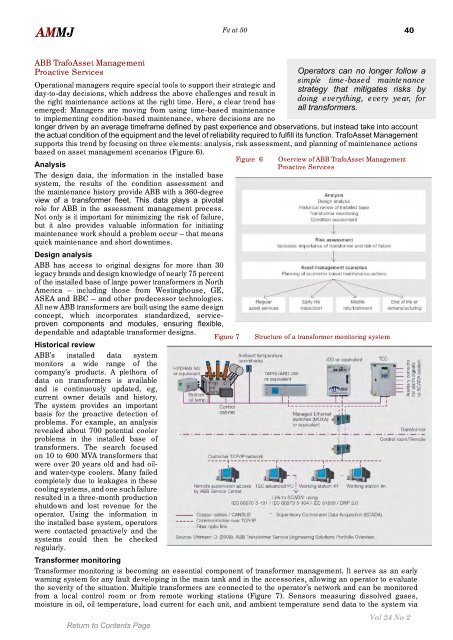April - Library
April - Library
April - Library
You also want an ePaper? Increase the reach of your titles
YUMPU automatically turns print PDFs into web optimized ePapers that Google loves.
AMMJ Fit at 50 40<br />
ABB TrafoAsset Management<br />
Proactive Services<br />
Operational managers require special tools to support their strategic and<br />
day-to-day decisions, which address the above challenges and result in<br />
the right maintenance actions at the right time. Here, a clear trend has<br />
emerged: Managers are moving from using time-based maintenance<br />
to implementing condition-based maintenance, where decisions are no<br />
longer driven by an average timeframe defined by past experience and observations, but instead take into account<br />
the actual condition of the equipment and the level of reliability required to fulfill its function. TrafoAsset Management<br />
supports this trend by focusing on three elements: analysis, risk assessment, and planning of maintenance actions<br />
based on asset management scenarios (Figure 6).<br />
Analysis<br />
The design data, the information in the installed base<br />
system, the results of the condition assessment and<br />
the maintenance history provide ABB with a 360-degree<br />
view of a transformer fleet. This data plays a pivotal<br />
role for ABB in the assessment management process.<br />
Not only is it important for minimizing the risk of failure,<br />
but it also provides valuable information for initiating<br />
maintenance work should a problem occur – that means<br />
quick maintenance and short downtimes.<br />
Design analysis<br />
ABB has access to original designs for more than 30<br />
legacy brands and design knowledge of nearly 75 percent<br />
of the installed base of large power transformers in North<br />
America – including those from Westinghouse, GE,<br />
ASEA and BBC – and other predecessor technologies.<br />
All new ABB transformers are built using the same design<br />
concept, which incorporates standardized, serviceproven<br />
components and modules, ensuring flexible,<br />
dependable and adaptable transformer designs.<br />
Historical review<br />
ABB’s installed data system<br />
monitors a wide range of the<br />
company’s products. A plethora of<br />
data on transformers is available<br />
and is continuously updated, eg,<br />
current owner details and history.<br />
The system provides an important<br />
basis for the proactive detection of<br />
problems. For example, an analysis<br />
revealed about 700 potential cooler<br />
problems in the installed base of<br />
transformers. The search focused<br />
on 10 to 600 MVA transformers that<br />
were over 20 years old and had oil-<br />
and water-type coolers. Many failed<br />
completely due to leakages in these<br />
cooling systems, and one such failure<br />
resulted in a three-month production<br />
shutdown and lost revenue for the<br />
operator. Using the information in<br />
the installed base system, operators<br />
were contacted proactively and the<br />
systems could then be checked<br />
regularly.<br />
Operators can no longer follow a<br />
simple time-based maintenance<br />
strategy that mitigates risks by<br />
doing everything, every year, for<br />
all transformers.<br />
Figure 6 Overview of ABB TrafoAsset Management<br />
Proactive Services<br />
Figure 7 Structure of a transformer monitoring system<br />
Transformer monitoring<br />
Transformer monitoring is becoming an essential component of transformer management. It serves as an early<br />
warning system for any fault developing in the main tank and in the accessories, allowing an operator to evaluate<br />
the severity of the situation. Multiple transformers are connected to the operator’s network and can be monitored<br />
from a local control room or from remote working stations (Figure 7). Sensors measuring dissolved gases,<br />
moisture in oil, oil temperature, load current for each unit, and ambient temperature send data to the system via<br />
Vol 24 No 2
















